#dinosaur from the Cleveland natural history museum
Text
DINOSAUR DINOSAUR DINOSAUR DINOSAUR DINOSAUR DINOSAUR DINOSAUR DINOSAUR DINOSAUR DINOSAUR DINOSAUR DINOSAUR DINOSAUR DINOSAUR DINOSAUR DINOSAUR DINOSAUR DINOSAUR DINOSAUR DINOSAUR DINOSAUR

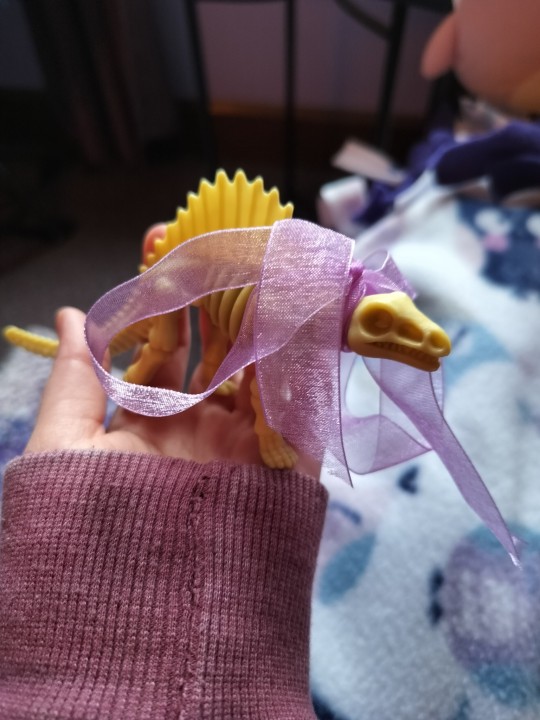

#dinosaur#dinosaurs#dino#dinosaur from the Cleveland natural history museum#dino toy#coquette#coquette dino#dino with a bow
5 notes
·
View notes
Note
What’s up with the DML archives?
The Cleveland Museum of Natural History has decided to stop hosting them. Here is a message that Mickey Rowe (one of the owners of the DML) sent to the list shortly after that happened:
The Cleveland Museum of Natural History has decided after 25 years that they can no longer devote the resources to maintaining the server where the dinosaur list archives were held. They are not coming back. Before they pulled the server, CMNH sent me two copies of the archive, one complete and the other "cleaned" of some of the spam that managed to get distributed (not clear to me how spam ever gets through since there are mechanisms in place to prevent it, but clearly they're not infallible).
If someone wants to find a host, please feel free. I'll be willing to provide the files from CMNH if someone wants to replace the full stretch of the archive back to February 1994 (which was when I became the list owner). I have no plans to search for a new host myself.
It was wonderful of CMNH to host the archives. We never asked them to. They never asked for anything in return. They originally created the archive for internal purposes as researchers there found them useful. They generously offered to make the archive publicly available if we were ok with them doing it. I was happy to say "yes" to that offer.
They believed, at least for a while, that the archive brought them traffic and thus was a good thing for them. I suspect that eventually changed. The world wide web is a very different place now compared to the late 1990s. I am sad to see the archive go away, but life moves on...
I’ve seen a few people offer potential solutions to give the archives a new home, but nothing has come of them yet, as far as I’m aware.
3 notes
·
View notes
Text
The Continuously Evolving Picture of the World's Largest Raptor
https://sciencespies.com/nature/the-continuously-evolving-picture-of-the-worlds-largest-raptor/
The Continuously Evolving Picture of the World's Largest Raptor
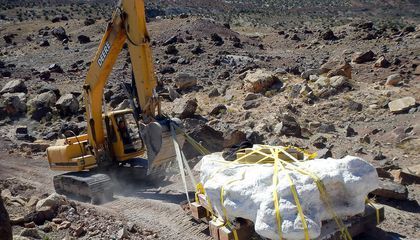
When Jurassic Park stomped into theaters during the summer of 1993, audiences suddenly became familiar with predators of the past like Dilophosaurus and Velociraptor. Right around that time, real-life paleontologists were figuring out an even bigger velociraptor relative, a dinosaur that has become a rock star in its own right.
Back in 1991, Utah State paleontologist Jim Kirkland and his crew were excavating a bonebed outside Moab, Utah, brimming with dinosaur fossils dating back 125 million years. While excavating an armored dinosaur that would eventually be named Gastonia (in honor of fossil reconstruction expert Robert Gaston), Kirkland found something more: the front of a jaw from a theropod, the class of dinosaurs containing such meat-eaters as T. rex. “Later that same field season, we found a sickle claw,” Kirkland recalls. The shape was unmistakable: The recurved claw was a dead ringer for the characteristic foot claw of dinosaurs like Deinonychus and Velociraptor, only this one was much larger. “It was twice as big as the same claw on Deinonychus,” Kirkland says.
Kirkland and his collaborators tossed around different names. “Dinoraptor” was a contender. At one point, there was a suggestion that the species name should be “spielbergi” to court the Jurassic Park director for some funding support. But the paleontologists ultimately went in a different direction.
That claw would become the single fossil that characterized a new animal: Utahraptor ostrommaysi. Its journey from rare find to state dinosaur of Utah to inspiration for the NBA’s Toronto Raptors illustrates the difficult, treacherous way in which scientists try to unravel the colossal carnivores that once roamed the planet.


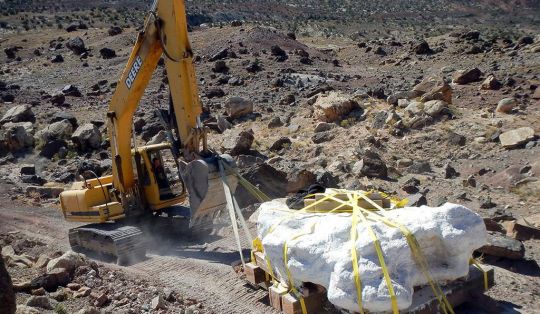

Utahraptor block being carried away for study in 2014.
(Jim Kirkland)
Many carnivorous dinosaurs live in scientific limbo for years. That’s because of the scarcity of fossils—simply put, large, predatory dinosaurs are rare, which makes sense from what we know about modern ecosystems. Plants will always outnumber herbivores, and herbivores will be more numerous than animals that eat them.
As luck would have it, though, a different team of paleontologists had stumbled upon Utahraptor decades before. In 1975, Brigham Young University paleontologist Jim Jensen collected a batch of theropod bones of about the same age from a nearby site called Dalton Wells. But few were fully prepared for study or described. They weren’t recognized as Utahraptor bones until years later when Kirkland recognized the similarities and the fossils were more fully-prepared.
Those bones made all the difference. Kirkland’s team had turned up a scant few bones from the jaw, foot, and leg at the new site. Based on the relationship of Utahraptor to other dinosaurs, the early representations of the dinosaur (including the journal description and an animatronic created for the Dinosaur Museum in Fruita, Colorado) depicted what was essentially a plus-sized Deinonychus. However, the Dalton Wells collection turned out to contain dozens of Utahraptor bones, enough to put pieces of multiple skeletons together to create a better version of the dino.
“Utahraptor is the largest dromaeosaur in the family,” says University of La Rioja paleontologist Angelica Torices. It is estimated to have stretched 23 feet long, weighed more than 600 pounds, and carried some deadly traits. “The claws on the hand seem to have been more specialized for cutting than other dromaeosaurs,” Torices says, and the teeth at the front of the lower jaw appear to angle forward farther than in other raptors.
Even so, Utahraptor probably used the same techniques that allowed most carnivorous dinosaurs to be efficient eaters. By studying various dinosaur teeth, Torices and colleagues found that carnivorous dinosaurs used a “grip and rip” feeding style. The dinosaurs would bite and pull backward, letting the serrations of their teeth do the work. Utahraptor probably chomped the same way.

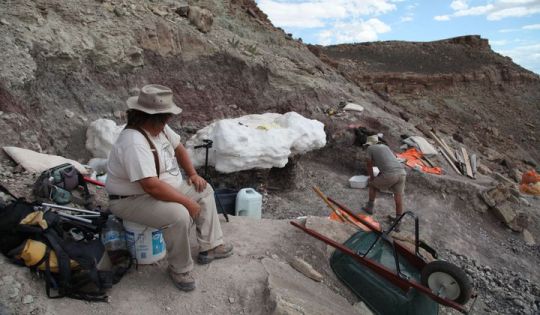
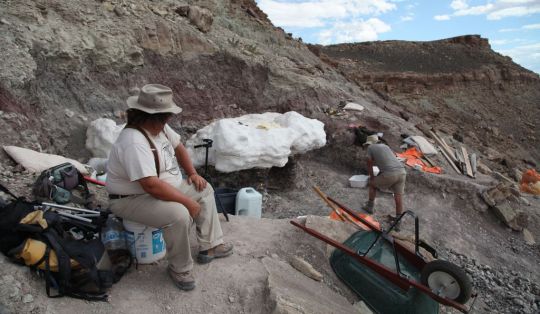

Block containing utahraptor fossils
(Jim Kirkland)
In the new century, new finds changed our image of Utahraptor again.
In 2001 a graduate student roaming around Moab spotted what initially looked like a human arm bone in an area of Early Cretaceous rock layers. The remains turned out to be more Utahraptor, and not an isolated bone or skeleton this time. When Kirkland and his team dug in, they unearthed dozens of Utahraptor bones from multiple individuals, from yearlings to full-grown adults, encased in a nine-ton block of Cretaceous quicksand. It took years of work to excavate and transport the block, but this collection contained the potential to provide a clearer view of Utahraptor than any of the earlier bonebed finds.
Excavations of the block are still underway, but we know it contains hundreds of bones, including skulls from three yearlings, five juveniles and one adult. Paleontological work is slow and exacting, but especially so in this case because the bones are tiny. The premaxilla (the front of the upper jaw) of a baby Utahraptor is about the size of a penny, for example.
The big bones, too, bring surprises. Adult Utahraptors were not 20-foot-long versions of Velociraptor, but much bulkier animals. “The new limb bones are 50 percent more massive than the same-sized Allosaurus bone,” Kirkland says, indicating that Utahraptor was more burly than slender. The skulls, too, look more like what you’d expect of a small tyrannosaur than a swift snapper.
Also, Utahraptor would have been fluffy. Recent discoveries connected to related dinosaurs including Velociraptor suggest Utahraptor would have been covered in feathers—a more elegant animal than the scaly renditions of dinosaurs common in the 1990s.
The Moab site might illuminate details of Utahraptor behavior as well. The nine-ton sandstone block containing the fossils appears to be a quicksand trap. The dinosaurs became stuck and were buried by the sloshy sediment that killed them. It’s unclear whether the animals were trapped at the same time or over a longer span, but the examination of how the bones are arrayed and the age of each Utahraptor might dovetail with evidence from tracks that some raptors were social and lived in groups.

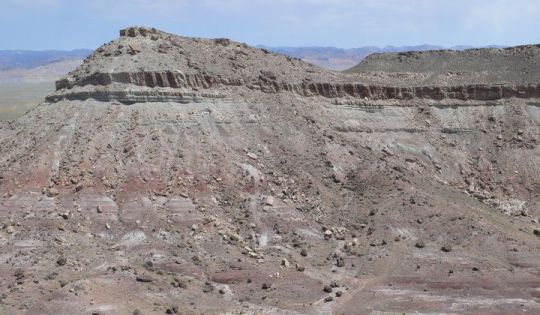


Utahraptor Ridge, Utah.
(Jim Kirkland)
All of these threads have made Utahraptor a Cretaceous celebrity. During the 1990s, the Toronto Raptors got their logo inspiration from Utahraptor and the dinosaur was the subject of the “paleofantasy” Raptor Red. Utahraptor has become such a dinosaur fan favorite that 10-year-old Kenyon Roberts was able to bend the ear of Utah state senator Curt Bramble and convince him that Utahraptor should become the state’s dinosaur.
Just one problem: Utah already had a state dinosaur. The Jurassic predator Allosaurus had been selected because of the huge amount of Allosaurus bones from more than 48 individual animals that had been uncovered in eastern Utah’s Cleveland-Lloyd Dinosaur Quarry.
It was a 21st-century dinosaur showdown. Some Utahans felt the state didn’t need a new state dinosaur and didn’t want to push aside part of the state’s fossil history. So a compromise was struck: In a 26-0 vote conducted in 2018, Utahraptor was made Utah’s state dinosaur and Allosaurus was shifted to be the state fossil. The Mesozoic meat-eaters were able to coexist as state symbols.
Utahraptor may be poised to jump to even greater fame. A proposal to preserve the Dalton Wells quarry as Utahraptor State Park recently ran through the Utah legislature. Unfortunately, the bill became a bit stuck—not unlike the dinosaurs themselves from the quicksand block. but when asked if there is still hope for the proposal, Kirkland says “Absolutely!”
Utah is rife with dinosaurs, but this super-sized raptor seems to be a cut above.
#Nature
1 note
·
View note
Text
Master List of Museums with Greek, Roman, Egyptian, and/or Near Eastern Antiquities in the United States of America

These collections may not be extensive or on display (and may contain only one culture from the above list), and I am including museums with minimal collections as well; please check with the museum before you visit or check their collections search online if the object(s) you wish to see is/are on view.
Feel free to message me if I’ve missed a museum! I’ll be constantly updating this post. (Initial Post: October 16, 2018; First Update: October 16, 2018, 2:18 p.m. Pacific; Second Update: October 16, 2018, 7:15 p.m. Pacific; Third Update: October 17, 2018, 6:29 p.m.; Fourth Update: October 21, 2018, 10:36 p.m.; Fifth Update: November 4, 2018, 9:06 a.m.; Sixth Update: June 1, 2019, 8:55 a.m.)
Alabama:
Anniston Museum of Natural History (Anniston, AL)
Birmingham Museum of Art (Birmingham, AL)
California:
Badè Museum of Biblical Archaeology (Berkeley, CA)
Iris & B. Gerald Cantor Center for Visual Arts at Stanford University (Stanford, CA)
J. Paul Getty Museum ("the Getty" which includes the Getty Center and the Getty Villa) (Los Angeles, CA)
Los Angeles County Museum of Art (Los Angeles, CA)
Phoebe A. Hearst Museum of Anthropology at the University of California, Berkeley (Berkeley, CA)
Robert and Frances Fullerton Museum of Art (RAFFMA) at the California State University, San Bernardino (San Bernardino, CA)
Rosicrucian Egyptian Museum (REM) (San José, CA)
San Diego Museum of Man (San Diego, CA)
Santa Barbara Museum of Art (Santa Barbara, CA) (Collection for Greek and Roman Art not on view, but can be found in Collections Search)
Colorado:
Denver Museum of Nature & Science (Denver, CO)
University of Colorado Boulder Art Museum (Boulder, CO)
Florida:
The John & Mable Ringling Museum of Art at Florida State University (Sarasota, FL)
Lowe Art Museum at the University of Miami (Coral Gables, FL)
Museum of Dinosaurs and Ancient Cultures (Cocoa Beach, FL)
Museum of Fine Arts, St. Petersburg (St. Petersburg, FL)
Tampa Museum of Art (Tampa, FL)
Georgia:
Michael C. Carlos Museum at Emory University (Atlanta, GA)
Illinois:
The Art Institute of Chicago (Chicago, IL)
The Field Museum (Chicago, IL)
The Oriental Institute at the University of Chicago (Chicago, IL)
Spurlock Museum of World Cultures at University of Illinois, Urbana-Champaign (Urbana, IL)
Krannert Art Museum at the University of Illinois, Urbana-Champaign (Champaign, IL)
Indiana:
Eskenazi Museum of Art at Indiana University (Bloomington, IN)
Gustav Jeeninga Museum of Bible & Near Eastern Studies at Anderson University (Anderson, IN)
Kansas:
Museum of World Treasures (Wichita, KS)
Maryland:
Baltimore Museum of Art (Baltimore, MD)
John Hopkins Archaeological Museum (Baltimore, MD)
Walters Art Museum (Baltimore, MD)
Massachusetts:
Arthur M. Sackler Museum at Harvard University (Cambridge, MA)
Berkshire Museum (Pittsfield, MA)
Fitchburg Art Museum (Fitchburg, MA)
The Harvard Semitic Museum (Cambridge, MA)
Museum of Fine Arts, Boston (Boston, MA)
The New Bedford Museum of Glass (New Bedford, MA)
Peabody Museum of Archaeology and Ethnology at Harvard University (Cambridge, MA)
Worcester Art Museum (Worcester, MA)
Michigan:
Institute of Archaeology & Siegfried H. Horn Museum at Andrews University (Berrien Springs, MI)
Detroit Institute of Arts (Detroit, MI)
Kelsey Museum of Archaeology at the University of Michigan (Ann Arbor, MI)
Minnesota:
Minneapolis Institute of Art (Minneapolis, MN)
Mississippi:
The Lois Dowdle Cobb Museum of Archaeology at Mississippi State University (Mississippi State, MS)
The University of Mississippi Museum (Oxford, MS)
Missouri:
Museum of Art and Archaeology at the University of Missouri (Columbia, MO)
Nelson-Atkins Museum of Art (Kansas City, MO)
Saint Louis Art Museum (St. Louis, MO)
Nevada:
Las Vegas Natural History Museum (Las Vegas, NV) (Note: the artifacts are replicas of the tomb of Tutankhamun and other Egyptian antiquities and are one of only two sets that were authorized by the Egyptian Ministry of Antiquities)
New Hampshire:
Hood Museum of Art at Dartmouth College (Hanover, NH)
New Jersey:
Newark Museum (Newark, NJ)
Princeton University Art Museum (Princeton, NJ)
New York:
The Brooklyn Museum (Brooklyn, NY)
Memorial Art Gallery at the University of Rochester (Rochester, NY)
Metropolitan Museum of Art (New York, NY)
The Morgan Library & Museum (New York, NY)
Museum of Greek, Etruscan and Roman Art in the William D. Walsh Family Library at Fordham University (New York, NY)
Onassis Cultural Center (New York, NY) (Note: exhibitions vary but may contain art from Ancient Greece)
Steinberg Museum of Art at Long Island University (Brookville, NY)
North Carolina:
Ackland Art Museum at the University of North Carolina at Chapel Hill (Chapel Hill, NC)
Gregg Museum of Art & Design at North Carolina State University (Raleigh, NC)
Nasher Museum of Art at Duke University (Durham, NC)
North Carolina Museum of Art (Raleigh, NC)
Ohio:
Cincinnati Art Museum (Cincinnati, OH)
Cleveland Museum of Art (Cleveland, OH)
Museum of Classical Archaeology at Ohio State University (Columbus, OH)
Museum of Natural History & Science (Cincinnati, OH)
Toledo Museum of Art (Toledo, OH)
Oklahoma:
Mabee-Gerrer Museum of Art (Shawnee, OK)
Oregon:
Hallie Ford Museum of Art at Willamette University (Salem, OR)
Prewitt–Allen Archaeological Museum at Corban University (Salem, OR)
Pennsylvania:
Barnes Foundation (Philadelphia, PA)
Carnegie Museum of Natural History (Pittsburgh, PA)
Kelso Museum of Near Eastern Archaeology at the Pittsburg Theological Seminary (Pittsburgh, PA)
Reading Public Museum (West Reading, PA)
University of Pennsylvania Museum of Archaeology and Anthropology (Philadelphia, PA)
Rhode Island:
Rhode Island School of Design Museum (Providence, RI)
Tennessee:
Art Museum of the University of Memphis (Memphis, TN)
Lynn H. Wood Archaeological Museum at Southern Adventist University (Collegedale, TN)
McClung Museum of Natural History and Culture at the University of Tennessee (Knoxville, TN)
The Parthenon (Nashville, TN) (Note: the Parthenon is more like a building of art itself as it’s a replica and the art in its galleries are not from the ancient world)
Texas:
Dallas Museum of Art (Dallas, TX)
The Houston Museum of Natural Science (Houston, TX)
Kimbell Art Museum (Forth Worth, TX)
The Museum of Fine Arts, Houston (Houston, TX)
San Antonio Museum of Art (San Antonio, TX)
Utah:
Utah Museum of Fine Arts (Salt Lake City, UT)
Utah State University Museum of Anthropology (Logan, UT)
Vermont:
Fleming Museum of Art at the University of Vermont (Burlington, VT)
Middlebury College Museum of Art (Middlebury, VT)
Virginia:
Chrysler Museum of Art (Norfolk, VA)
Virginia Museum of Fine Arts (Richmond, VA)
Washington:
Seattle Art Museum (Seattle, WA)
Washington, D.C.:
Freer Gallery of Art (Washington, D.C.)
West Virginia:
Huntington Museum of Art (Huntington, WV)
Wisconsin:
Logan Museum of Anthropology at Beloit College (St. Beloit, WI)
Milwaukee Art Museum (Milwaukee, WI)
#museum#museums#United States#United States of America#America#USA#U.S.A.#ancient art#ancient Greece#ancient Egypt#ancient Rome#ancient Near East#ancient history#ancient artifacts#archaeology#Classical archaeology#Near Eastern archaeology#long post
2K notes
·
View notes
Text
Sauropods and pterosaurs in the Outback
Dinosaur of the day Magyarosaurus, an armored dwarf sauropod from a Cretaceous European island.
Interview with Philip Mannion, Steve Poropat, and Adele Pentland. Paleontologists at the Australian Age of Dinosaurs museum in Winton, Queensland. We discussed the new sauropods literally coming up out of the ground in the Outback as well as a brand new pterosaur, Ferrodraco.
Here is the video of our visit to the Australian Age of Dinosaurs Museum.
In dinosaur news this week:
A new small ceratopsian was named Ferrisaurus from northern British Columbia, Canada
A new study shows just how fast dinosaurs could replace their teeth
The Cleveland Museum of Natural History has a new exhibit called Ultimate Dinosaurs
The Natural History Museum in Los Angeles is having an Antarctic Dinosaurs Family Day
This episode is brought to you in part by Why Dinosaurs? The feature length documentary celebrating dinosaurs and the people who love them, created by father and son team Tony and James Pinto, support them and get perks on Indiegogo.
To get access to lots of patron only content check out https://www.patreon.com/iknowdino
For links to every news story, all of the details we shared about Magyarosaurus, links from Philip Mannion, Steve Poropat, and Adele Pentland, and our fun fact check out https://iknowdino.com/Magyarosaurus-Episode-262/
Check out this episode!
4 notes
·
View notes
Photo
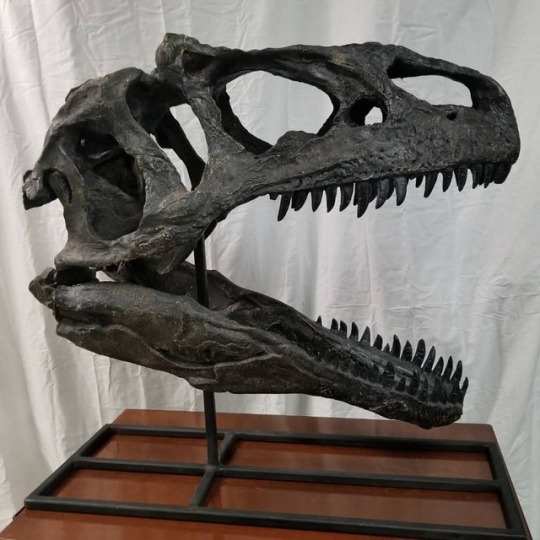
This is a museum cast of an Allosaurus skull - an apex predator, theropod, dinosaur! These ferocious reptiles roamed the Earth in the late Jurassic period (155-150 million years ago). Armed with dozens of sharp, serrated, teeth, and averaging 8.5m (28ft) in total length, this dinosaur was a powerful killing machine. This full-size skull is cast from a real allosaurus skeleton that was excavated in the Dinosaur National Monument of Utah & Colorado. The real skull is on display at this national park and this cast is used on the articulated skeleton! You can also find this exact casting on display at the Cleveland Lloyd Dinosaur Quarry, the Natural History Museum of Utah and several other facilities across the continent. This is a rare opportunity to privately own a museum-grade specimen! This dinosaur skull measures just shy of 3ft (90cm) long, and (including stand) ~32.5" (82.5cm) tall and 1ft (30cm) wide. Worldwide shipping is available. We are asking $6450CAD (~4890USD), buy it now on www.SkullStore.ca or in-store Thursday-Sunday (12-6pm) at 1193 Weston Rd, Toronto. (at Skull Store) https://www.instagram.com/natural_selections/p/BuT_tvjgDPS/?utm_source=ig_tumblr_share&igshid=ue9667mdijn9
20 notes
·
View notes
Photo
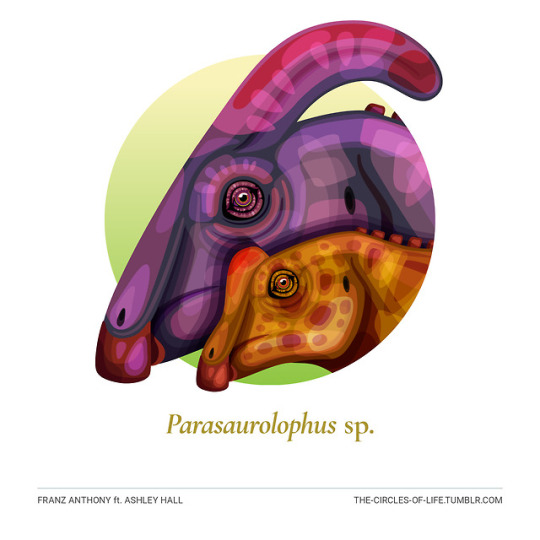
Parasaurolophus sp.
ft. Ashley Hall
“Parasaurolophus is my ALL-TIME favorite dinosaur, but I can’t tell you why. It just always has been. Has that ever happened to you?” Ashley Hall confesses.
“Hadrosaurs, the group that Parasaurolophus belongs to, aren’t everyone’s favorite as people tend to gravitate towards the swift, toothy theropods. But there’s something about that head crest that I loved as a little girl and still do today.”
Fossils have always been a big part of her life. “My parents don’t know how I got interested in paleontology. Whether it was a dinosaur book or TV show that got my attention, I was immediately hooked for life.” Her parents definitely embraced this by taking Ashley and her brother to the Field Museum of Natural History in Chicago at every occasion that they could.
To her, fossils are a snapshot of a moment of time in Earth’s history. People often forget is that even the biggest, mightiest dinosaurs were small at one point in their lives, but Ashley definitely won’t.
At one point in her career, she had the chance to dig up the first and only known baby Parasaurolophus known as “Baby Joe.” For her, “It was a pleasure and a dream come true to see such a wonderful, one-of-a-kind fossil; my favorite from childhood.”
Like rare fossils involving pigment and soft tissue, “Joe” helps us paint clearer pictures of the distant past. It had a nub on top of its head, meaning that the majestic crest Ashley always loved grew with the animal itself.
Today, she designs adult programs for the Cleveland Museum of Natural History. “Like a gem, my job has many facets. Besides planning and conducting adult programs, I also teach classes for grades K-12 at the Museum, video conferencing with schools in different states and countries, and take our programs on the road.” On top of it all, she plans large-scale events such as annual film festivals and fundraisers.
Despite all the rave that dinosaurs get, she’s aware that fossils aren’t part of every person’s life. “This is why I’m a huge fan of sharing science on social media, at schools, and to the public in general. We have a huge disconnect from science literacy today, and I’m working every day to fix that.”
—
Ashley Hall is an Adult Programs Coordinator at the Cleveland Museum of Natural History.
Get to know Ashley and why she wants everyone to know about paleontology!
Twitter ·
Instagram
· Tumblr
—
My main blog · Ko-fi · Patreon
201 notes
·
View notes
Photo

HAPPY #FossilFriday! Look at this GORGEOUS specimen! Allow me to gush. [LONG POST!] Anhanguera santannae (AMNH22555) is one of the BEST preserved pterosaur fossils in the world and we have been lucky enough to have it at the Cleveland Museum of Natural History for the last several months. It is SO rare to get this quality of preservation in the fossil record. Why? Taphonomy: the study of what happens to an organism after death. You have to die in the right time in the right place and then lie undisturbed for millions (MILLIONS!) of years until a bipedal ape finds you, digs you up and tries to makes sense of you. Paleontologists really are superheroes when you think about it. This pterosaur and many other beautifully preserved three-dimensional fossils have been found in carbonate concretions in the Romualdo Member of the Santana Formation (Araripe Basin, northeastern Brazil). Some 25 species of fossil fishes have often been found with stomach contents preserved, helping paleontologists to better study predator–prey relationships. Pterosaurs, reptiles, amphibians, invertebrates, crocodylomorphs, plants, and even dinosaurs have been found here. Limestone accretions formed nodules around dead organisms, preserving soft and hard parts of their anatomy. These nodules are then taken to a lab and etched away with acid, revealing beautiful bone inside. The American Museum of Natural History (@amnh) creates traveling exhibitions of incredible quality (we've had several now!) and I can't wait to see what they have in store for the future! 📷 1-4: mine 📷 5: Pinheiro 2017 from https://peerj.com/articles/3285/ #pterosaurs #anhanguera #museum #naturalhistorymuseum #science #cle #fossil #fridayfeeling #notadinosaur #wearestemsquad #wearescience #scicomm #amnh #cleveland
#fossilfriday#pterosaurs#anhanguera#museum#naturalhistorymuseum#science#cle#fossil#fridayfeeling#notadinosaur#wearestemsquad#wearescience#scicomm#amnh#cleveland
8 notes
·
View notes
Text
Aside from writing, I’m going to mention a job I’d like to have, one that I could absolutely manage for the most part, that I’d enjoy and would find inspiration and atmospheric and brilliant (and have felt this way for years):
Vacuuming a museum at night. Cleaning out trash bins, vacuuming, dust mopping, mopping, etc. Even bathrooms would be okay, but I’d prefer to avoid them - but I could handle that for the privilege to just be in a museum when it’s quiet, enjoying myself as I clean the floor around mummies and dinosaur bones.
I could think about my writing and still be able to focus on these chores. And I’m willing to bet they let you listen to music, so I’d be happy to do that. :D
I’d really fucking love a job like this, I am 100% serious. It would be great, as long as I’m doing it at nighttime when there’s no one around! (Though I wouldn’t mind a couple of museum staffers about, and I assume there would be some tucked away in an office somewhere.) Also... a couple of my original stories have workers in museums, so this would be a great place to get ideas for that!
This all dates back to when I was 12 and my grandparents and cousin bullied me into going to Cleveland for a wedding for my mom’s cousin. I wasn’t happy about it, but my favorite part was that the reception was at a museum (I believe it was the Cleveland Museum of Natural History) and we had some parts open to us. It was generally quiet since most of the people at the reception didn’t have any interest in wandering around the places open to us, but I got to see Lucy! :D
Since then, sometimes I think it’d be a good setting for me. Not too many people, the right environment, exactly up my alley, and I like to make things clean~
7 notes
·
View notes
Text
Columbus Ohio is a Wonderful Place to Live
Columbus Ohio is the state capital of Ohio. The city is situated on the riverfront of Cleveland, Ohio. The city's Scioto Avenue is a cluster of beautiful parks, with many walking paths and an enormous interactive fountain. On the east bank, there is the COSI Science Center, with exhibits on the planet, human spaceflight and solar systems.
Downtown Columbus is dominated by the Ohio Statehouse and the convention center. There is also the beautiful skyline of the city. The German Village is on the west side of the river with homes that date back to 1800s.
The German Village is home to the largest museum in the entire city. The Science Museum features over fifty exhibits. The Science Center is home to many exhibits of space exploration. The city also has several historical sites that contain beautiful collections.
Columbus is also home to one of the largest populations of immigrants and refugees in the country. Since 1820, Columbus has welcomed millions of immigrants to its shores. This has created a rich history and cultural identity for the city. The Columbus Ohio Museum is an example of this heritage. The museum's collection features an extensive variety of artifacts from various cultures and eras.
The state of Ohio is home to an exciting culture of theaters. The Columbus Opera House is one of the top-performing opera theaters in the world. The Columbus Museum of Art is a national landmark. The National Museum of American History is another of the most impressive museums in the United States.
The Columbus Zoo & Aquarium are a major tourist attraction. The Zoo houses one of the largest collections of aquatic and land mammals in the United States. The Columbus Zoo and Botanical Garden are one of the world's premier gardens.
Columbus is also home to the oldest functioning city government building in the world, the Federal Building. Columbus also contains the only courthouse in the United States, as well as the oldest municipal building in the United States. The city is home to the headquarters of several government agencies including, the state government, county government, school district, and city hall.
Ohio is also one of the leading states of the union when it comes to business and industry. Columbus offers many job opportunities for people. With the help of a number of professional and trade organizations, the state of Ohio is one of the fastest-growing industries.
Columbus is also home to numerous colleges and universities. The Columbus University and the Wright State University are some of the well-known universities located in the city.
Columbus is also one of the leading cities in the state of Ohio. The city hosts many major events throughout the year. The annual Columbus Jazz Festival, the Columbus Blues Festival, and the Columbus Symphony Orchestra are just a few of the events that happen during the summer months. The Columbus Zoo holds the largest dog show in the country.
Columbus is also one of the largest cultural and world-class entertainment centers in the state of Ohio. The popular annual Midsummer Classic is a popular event that attracts people from around the country. The Columbus Museum of Art hosts the largest Columbus Arts and Crafts Festival in the world. The Columbus Zoo & Aquarium houses many species of exotic animals and reptiles.
The Columbus Children's Museum is home to the largest collection of dinosaurs and other extinct animals in the United States. Columbus Zoo features a huge collection of rare species. The Columbus Museum of Natural History is also located in the city. The Columbus Museum of Art is also located in the city.
Columbus Ohio is an exciting place to live. There is much to offer residents and visitors. Whether you are looking to make a great move, relocate to a new city, or retire in one of the largest cities in the state of Ohio, Columbus Ohio is the best option for you.
0 notes
Text
Dwarf Tyrannosaurus-Rex Dinosaurs Probably Did Not Exist: Study
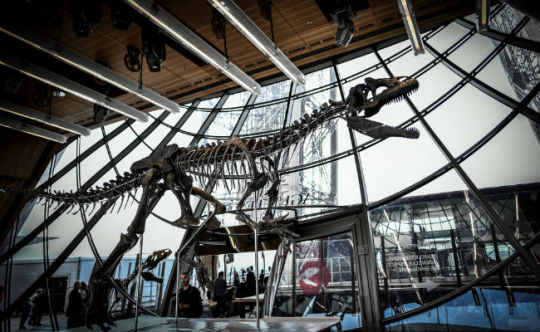
A team discovered the nearly complete skeleton of a small Tyrannosaurus in Montana (File)Washington: For three decades, paleontologists the world over have been split over a provocative finding: did a dwarf species of Tyrannosaurus rex really once exist?In 1988, paleontologist Robert Bakker and his colleagues at the Cleveland (Ohio) Museum of Natural History reclassified a specimen first discovered in 1942 and displayed at the museum.It was, they said, the first known member of a small new species they baptized as the Nanotyrannus.Then, in 2001, another team discovered the nearly complete skeleton of a small Tyrannosaurus near the town of Ekalaka in Montana, in the rich and intensively studied fossil formation known as Hell Creek.They named the creature barely bigger than a draft horse Jane and soon classified it as a juvenile Tyrannosaurus rex.But a minority of specialists continued to insist that it was part of the newly classified Nanotyrannus species. They pointed to the morphology of its skull and bones, which they said differed from T-rex adults.Answers in the bonesIn a study published Wednesday in the journal Science Advances, researchers led by Holly Woodward of Oklahoma State University performed a microscopic analysis on samples from the interior of Jane's tibia and femur bones, as well as from a less complete set of bones from an animal dubbed Petey. This technique, known as paleohistology, confirmed that the two were immature individuals not adults, the scientists said.By extension, the study's authors said, the existence of the Nanotyrannus seems very unlikely."The really cool thing about fossil bones is that a whole bone fossilizes even down to the microscopic size," Woodward told AFP."We can infer growth rate, age (and) maturity level."The researchers took extremely fine slices from the bone samples, so thin that light could pass through them and then studied them under powerful microscopes.The size of the blood vessel openings revealed that the two dinosaurs were still in a phase of rapid growth at the time of death. Had they been adults, this vascularization would have been less prominent.Only a half-dozen specimens The team was also able to count the growth rings in each animal's bones, much as one can do to determine the age of a tree: 13 years for Jane, and 15 for Petey.The study adds to scientists still limited knowledge of the 20-year period between a dinosaur's hatching and its adulthood.Jane, who weighed only one ton, died before reaching the phase of exponentially rapid growth that normally would have brought her to an adult weight of just under 10 tons. "Everyone loves T-rex, but we don't really know much about how it grew up," Woodward said. "It's probably the most famous dinosaur in the world, and we mostly just have really large skeletons of it."That is partly due to the obsession of collectors and the public with finding and displaying the most enormous T-rex skeletons possible unearthed sometimes to the detriment of smaller specimens.Unfortunately, Woodward said, only five to seven fossils of young T-rex dinosaurs are known to exist in the world, and some of those are in private collections not accessible to researchers.(Except for the headline, this story has not been edited by NDTV staff and is published from a syndicated feed.)
Read the full article
#010oct161920#1bbc#1minutenews#2killednews#2tradecenternews#247anchor#3news#3warglobalnews#6abctonight#6anchors#7cup#7record#7recordattempt#8aloysiusaloysius#8mediacorp#8singapore#8twitter#8worldfacebooklive#8worldfb#8worldlive#8worldorchardtower#9cup#9msnnews#9record#911news#91101record#apquiz#abc4am#abcnews#abc7tonight
0 notes
Photo
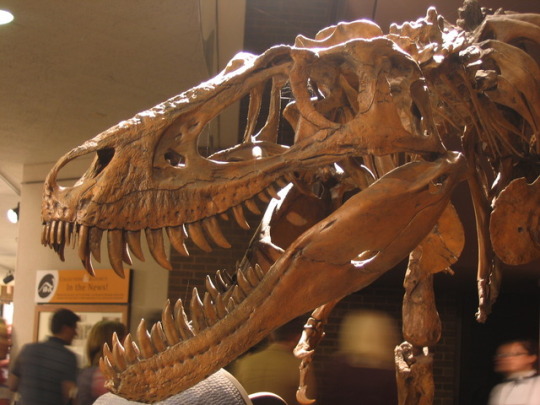

Another Theropod Tuesday! This is the (restored) skull of Nanotyrannus lancensis on a mount at the Cleveland Museum of Natural History. The holotype specimen of this dinosaur comes from the uppermost Cretaceous Hell Creek Formation of Montana. Debate still rages on whether Nanotyrannus is a valid genus of small tyrannosaurid or if it is a juvenile Tyrannosaurus rex. I am not jumping into that debate because I have not studied the specimens or the issue much!
#theropod#dinosaur#Nanotyrannus#Tyrannosaurus#Late Cretaceous#Hell Creek#Montana#Cleveland Museum of Natural History#museum#display#exhibit#mount#paleontology#geoscience#geology#science
2 notes
·
View notes
Photo

Mark Schultz is an American comic book writer and illustrator best known as the creator of XENOZOIC TALES (aka Cadillacs and Dinosaurs); which is widely considered one of the best (if not THE best) dinosaur comics ever produced.* Schultz graduated from Kutztown University of Pennsylvania in 1977 with a Bachelor’s in Fine Arts. Though a life long fan of comics, Schultz initially had no aspirations to enter the field as a career and originally worked as a commercial illustrator.
In 1974 that changed when Schultz was given the opportunity to ink the backup story in Marvel’s Savage Sword of Conan #132. With the black and white independent comics movement getting underway in the early 1980s, Schultz - unsatisfied with his work as an illustrator - pitched an idea for an original series to indy comics company Kitchen Sink Press.
Drawing off his life long love of dinosaurs, automobiles, the pulp adventure fiction of Edgar Rice Burroughs, Robert E. Howard, and H.P. Lovecraft as well as films from the Golden Age of Hollywood, Schultz crafted the series XENOZOIC TALES.
Distilled down to its barest fundamentals, XENOZOIC TALES is essentially George Miller’s Mad Max + Dinosaurs. Set in the 22nd Century after an unspecified cataclysm has reduced human civilization to a shell of its former self and (somehow) caused extinct prehistoric creatures ranging from dimetrodons to dinosaurs to wooly mammoths to return to reclaim the Earth.
The series’ two protagonists are Jack Tenrec and Hannah Dundee. Jack is a blue collar environmentalist modeled after John Wayne’s character in the film HATARI! (1962, Dir. Howard Hawks). This means that Jack believes in respecting and protecting the Earth and its creatures, not because he’s a tree-hugging hippie but rather because he is keenly aware of just how dangerous the forces of nature can be. In this respect he rather resembles L. Sprague de Camp’s time-traveling big game hunter Reginald Rivers from the Rivers of Time prose series (1956-1993). Jack operates out of a massive garage located on the outskirts of The City in the Sea (what was once NYC) and in his spare time restores 20th-Century Cadillac cars - retrofitting them to run on a totally different kind of fossil fuel: dinosaur guano.
Conversely Hannah, modeled principally after actress Barbara Stanwyck, is a diplomat (i.e. spy) from the neighboring city of Wasoon (implied to have been Washington DC). Hannah is interested in gaining access to the secret vaults located beneath The City in the Sea which may hold the answers to what caused the great 20th-Century catacylsm which transformed the planet into the prehistoric post-apocalyptic world it is now.
XENOZOIC TALES first appeared in the horror comics anthology Death Rattle #8 and then subsequently in its own series. Each issue featured one or two stories written and drawn by Schultz and one story written by Schultz and drawn by artist Steve Stiles who Schultz recruited to help lighten the workload. The series became both a commercial and critical success, winning four Harvey Awards and three Eisner Awards. The success of JURASSIC PARK (1993, Dir. Stephen Spielberg) further galvanized interest as producers began to look for the next big paleo-fiction title. Soon Schultz was inundated with offers to turn his series into a Saturday morning cartoon, a toyline from Tyco, and a video game by Capcom. Unfortunately none of these ventures turned out as successful as one might have hoped - the cartoon was cancelled after one season, the toy line was of poor quality and failed to sale, the video game was popular but not enough to produce any follow-ups - and as result ended up loosing Schultz money.
To stay financially solvent, Schultz temporarily ended XENOZOIC TALES with Issue #14 in October of 1995 and began taking on other projects. Many of these nevertheless still played to Schultz’s interests including doing interior illustrations and the cover painting for Wandering Stars’ new edition of Robert E. Howard’s Conan the Barbarian stories (later reprinted by Del Rey) and for the posthumously published autobiography of artist Charles R. Knight; the grandfather of all paleo-artists. Schultz also teamed up with paleontologist Michael Ryan, of the Cleveland Museum of Natural History, to co-author the four issue comic miniseries SUBHUMAN (Dark Horse, 1998).
In early 2015, Schultz published an illustrated novel, STORM AT SEA (Flesk Publications) which has been described by the author as a soft prequel to XENOZOIC TALES set prior to the great cataclysm. Later that same year Schultz announced that he had begun work on a new XENOZOIC TALES graphic novel (a proposed 62 pages). As of this writing Schultz is still working on it.
Above: Jack, Hannah and Jack’s pet allosaurus Hermes enjoy some quality reading material.
*Personally I rank XENOZOIC TALES second, right behind Pat Miller’s FLESH (2000 AD, 1977 - Present) as the best dinosaur comic.
#mark schultz#xenozoic tales#cadillacs and dinosaurs#comics#subhuman#comic books#flesk publications#dinosaur#dinosaurs#storm at sea#dark horse comics#kitchen sink press
19 notes
·
View notes
Text
I Know Dino Podcast Show Notes: Montanoceratops (Episode 207)
I Know Dino Podcast Show Notes: Montanoceratops (Episode 207)
Episode 207 is all about Montanoceratops, a primitive ceratopsian with an unusually deep tail thanks to its vertebral spines.
We also interview Ashley & Lee Hall, both from the Cleveland Museum of Natural History. Ashley is the Adult Programs Coordinator and Lee is a Preparator and Lab Manager. But more importantly, like us, their wedding heavily featured dinosaurs. Follow Ashley on twitter & Ins…
View On WordPress
2 notes
·
View notes
Photo

I may be way too sick to work today, but nothing was going to stop me from popping in for the arrival of an allosaurus skull! The skull is cast from a skeleton found at Dinosaur National Monument. The original skull is on display there, and this skull cast is used on the articulated skeleton. You can also see this cast on display at the Cleveland Lloyd Dinosaur Quarry, the Natural History Museum of Utah and other major museums across the continent. And YES! IT'S FOR SALE! Until the end of February we have it marked down to $5800CAD (~4400USD) from $8500CAD (6500USD). Drop me a message or email [email protected] for serious inquiries. (at Skull Store) https://www.instagram.com/natural_selections/p/BuJ1MkwAESD/?utm_source=ig_tumblr_share&igshid=fsrggp7ck5kk
15 notes
·
View notes
Photo

Hi everyone and to new followers! Like my #scicomm? Instagram's algorithm is changing. Turn on notifications to never miss a post. Who am I? I’m Ashley Hall: Adult Programs Coordinator at the Cleveland Museum of Natural History. I create fun and educational programs for adults at the museum, but also in conjunction with other local institutions like libraries, movie theatres, hiking stores, and more. Like a gem, my job is multi-faceted. Besides planning and conducting adult programs, I also teach classes for grades K-12 at the Museum in the galleries in the mornings, video conferencing classes with schools in different states (and countries!), and I also take our programs on the road (Science-to-Go!). I am a paleontologist and informal educator by training. I hold a B.A in Anthropology and Animal Behavior from Indiana University Bloomington. I studied animal bones at archaeological sites in Kansas and Wyoming to determine diet in Protohistoric plains hunter-gatherer groups. After college, I decided to pursue my lifelong dream of working in a natural history museum. I spent 7 years working in the Education Division at the Natural History Museum of Los Angeles (@NHMLA) and the world famous La Brea Tar Pits where I was able to design research-based programming (public tours, school programs) to a wide variety of audiences. During this time, I worked for 5 years as Assistant Curator at the Raymond M. Alf Museum (@alfmuseum) of Paleontology under ceratopsian expert Dr. Andrew A. Farke where I excavated, catalogued, identified, and curated fossils from Bureau of Land Management Land from the Grand Staircase-Escalante National Monument. While I don't have a PhD or Masters, I’ve published research on Pleistocene birds from the La Brea Tar Pits with Don Prothero and sauropod dinosaurs with my husband, Lee Hall (@paleeoguy). I love sharing my passion of natural history through social media, so feel free to follow my adventures on Instagram and Twitter! #museumed #ohiomuseums #naturalhistory #cleveland #cmnh #cle #wearestemsquad #wearescience #womeninstem #stem #science #jurassicpark #scied #scicomm #ohio #educator #paleontology #dinosaurs (at Cleveland Museum of Natural History)
#stem#cle#ohio#naturalhistory#scicomm#science#jurassicpark#educator#wearescience#paleontology#dinosaurs#cleveland#ohiomuseums#museumed#cmnh#womeninstem#scied#wearestemsquad
4 notes
·
View notes